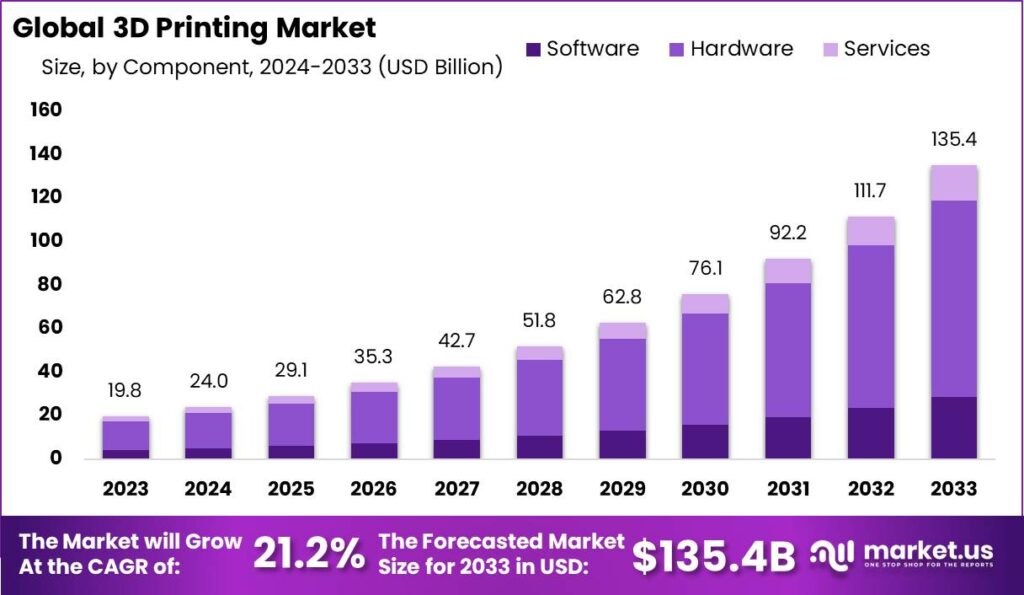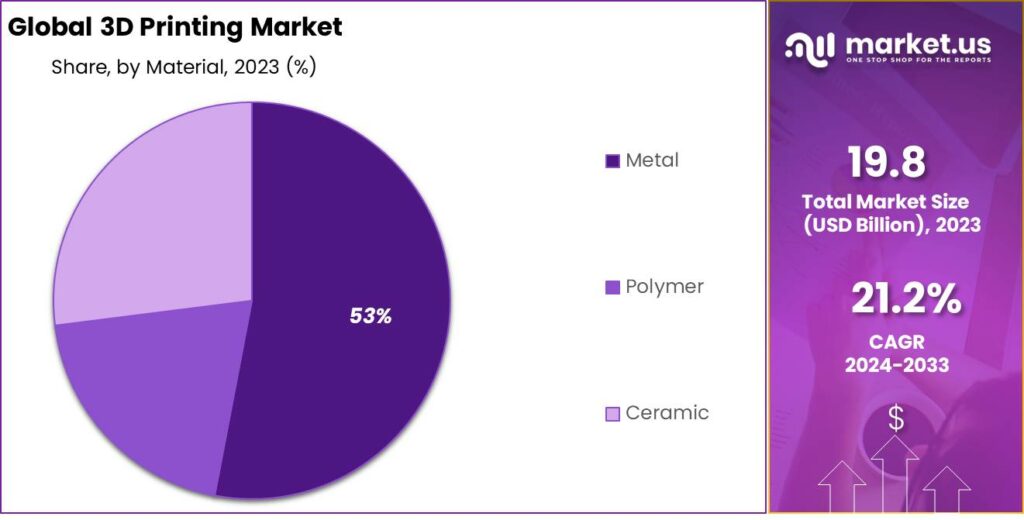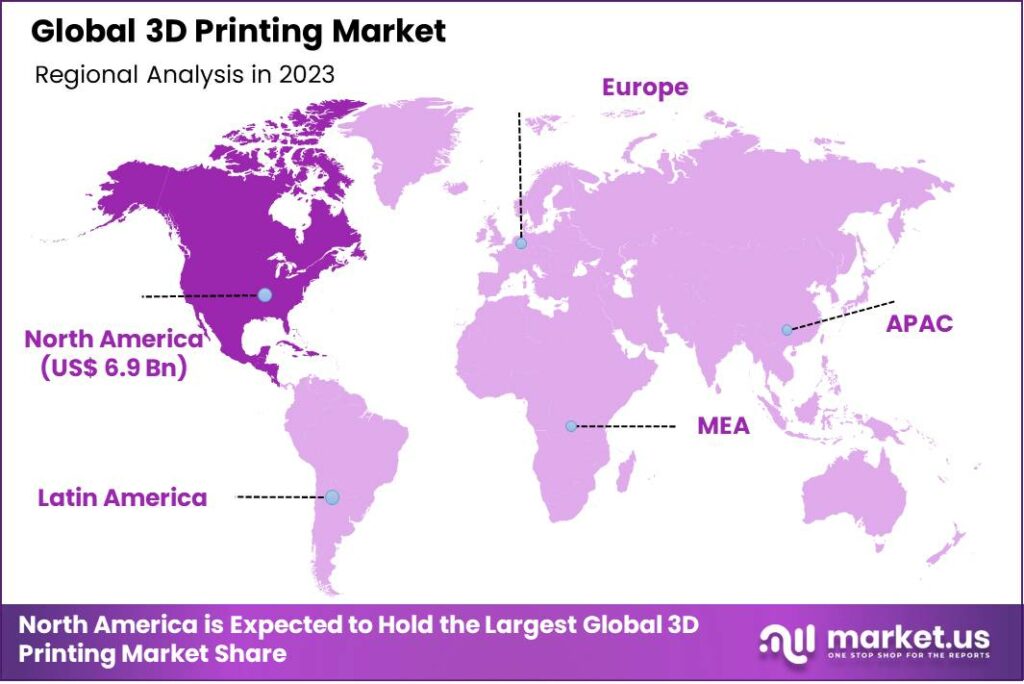New York, Jan. 03, 2024 (GLOBE NEWSWIRE) -- According to Market.us, The Global 3D Printing Market size is poised for significant growth, reaching USD 24 Billion in 2024. The sales are expected to witness a robust CAGR of 21.2% from 2024 to 2033. By 2033, the 3D printing demand is anticipated to reach a valuation of USD 135.4 Billion.
3D printing, also known as additive manufacturing, is a process of creating three-dimensional objects by layering or adding material together, typically from a digital model or design. It is a transformative technology that has gained significant attention and adoption across various industries due to its unique capabilities and advantages.
The 3D printing market refers to the global market for 3D printing technologies, materials, software, and services. It encompasses the entire ecosystem of 3D printing, including hardware manufacturers, material suppliers, software developers, service providers, and end-users. Continuous advancements in 3D printing technologies have expanded the scope and capabilities of the technology. Improved precision, speed, and material options have made 3D printing more accessible and versatile, enabling the production of complex geometries, customized products, and functional prototypes.
Don't miss out on business opportunities | Get sample pages at: https://market.us/report/3d-printing-market/request-sample/
("Before you plan to Invest? Explore our comprehensive studies or reports by opting for sample reports. They provide an excellent opportunity to assess the depth and quality of our analyses before making a decision.")

3D Printing Market Key Statistics
- The 3D Printing Market is expected to reach USD 135.4 billion by 2033, with a steady CAGR of 21.2% over the forecast period.
- Hardware dominates with over 67% market share, followed by Software and Services.
- Industrial 3D Printers hold a dominant position with over 75% market share due to their precision and compatibility.
- Prototyping commanding over 54% of the market share due to its role in rapid and cost-effective product development.
- Metal printing holds a commanding market share of over 53%, driven by its precision and durability.
- The North America held a leading position within the world of 3D printing with a staggering percentage of more than 35%.
- Leading companies in the 3D printing market include Stratasys Ltd, Materialise, EnvisionTec Inc, 3D Systems Inc, and GE Additive, among others.
For instance,
- In February 2022, the government of India set an ambitious goal to secure a 5% share of the global 3D printing market. The aim is to contribute approximately USD 2-3 billion to the country's GDP within the next 2-3 years. As part of this initiative, the government plans to develop 50 India-specific technologies focusing on materials, machines, processes, and software. The overarching objective is to establish India as a hub for 3D-printed design and manufacturing
- In October 2022, AML3D, an Australian company specializing in metal 3D printing, expanded its collaboration with Boeing, a prominent aircraft manufacturer. Initially tasked with 3D printing aluminum prototype airplane components for intensive testing, AML3D met the requirements of AS9100D quality assurance for functional parts. Building upon this successful collaboration, the project's scope has been broadened to include additional 3D-printed components, resulting in a 150% increase in the overall agreement's value.
Get deeper insights into the market size, current market scenario, future growth opportunities, major growth driving factors, the latest trends, and much more. Buy the full report here
Factors influence the growth of 3D Printing Market
- Technological Advancements - Continuous improvements in 3D printing technology like higher precision and accuracy, ability to print with multiple materials and colors, and increasing speed are expanding the capabilities and applications of 3D printing.
- Increased Adoption - Drop in 3D printer prices and expired key patents have led to increased adoption of 3D printing technology by hobbyists, educators, and professional users. This drives overall market growth.
- Customization - Ability to easily customize and personalize products through 3D printing is leading to growth in applications like prosthetics, implants, accessories, footwear, etc.
- Government Investment - Government funding for R&D in 3D printing technology and promotion of additive manufacturing through various initiatives is boosting market growth.
- Manufacturing Applications - 3D printing is being increasingly used for rapid prototyping, production of specialized components and short-run manufacturing. This reduces costs and lead times.
- Sustainability - Additive manufacturing processes used in 3D printing create less material waste compared to traditional subtractive processes. This makes it more sustainable.
- Supply Chain Resilience - 3D printing enables on-demand localized production. This provides flexibility and resilience for supply chains facing disruptions.
- New Materials - Development of innovative 3D printing materials like advanced composites, bio-compatible polymers and nano materials is enabling new applications and driving market expansion.
Report Segmentation
Component Analysis
In 2023, the hardware segment emerged as the dominant component in the 3D printing market, capturing a substantial market share of over 67%. This can be attributed to the critical role that hardware plays in the 3D printing process, including the printers, scanners, and other equipment required for additive manufacturing. The hardware segment encompasses the various technologies and machines used to create three-dimensional objects, such as stereolithography (SLA), selective laser sintering (SLS), fused deposition modeling (FDM), and digital light processing (DLP) printers.
The high market share of the hardware segment can be attributed to the increasing adoption of 3D printers across industries for prototyping, tooling, and end-part production. With advancements in hardware technologies, including improved speed, accuracy, and material compatibility, 3D printers have become more efficient and reliable, driving their widespread adoption.
Printer Type Analysis
In 2023, the industrial 3D printer segment emerged as the dominant printer type in the 3D printing market, capturing a significant market share of over 75%. This can be attributed to the widespread adoption of industrial 3D printers across various industries, including aerospace, automotive, healthcare, and manufacturing. Industrial 3D printers are known for their high precision, large build volumes, and the ability to handle a wide range of materials, including metals, plastics, and composites. These printers are primarily used for rapid prototyping, functional part production, and tooling applications.
The dominance of the industrial 3D printer segment can be attributed to the increasing demand for advanced manufacturing technologies, the need for complex and customized parts, and the ability to achieve high-quality outputs at scale. As industries continue to leverage the benefits of additive manufacturing for production-grade applications, the industrial 3D printer segment is expected to maintain its market leadership.
Technology Analysis
In 2023, the Stereolithography segment emerged as a frontrunner in the 3D printing market, securing a significant market share of over 11%. Stereolithography, a popular 3D printing technology, utilizes a photopolymerization process to create solid objects from liquid resin. The dominance of the Stereolithography segment can be attributed to its ability to produce high-resolution prints with exceptional surface finish, making it ideal for applications in industries such as automotive, aerospace, and healthcare.
Furthermore, the segment's growth was fueled by advancements in materials used in Stereolithography, enabling the production of functional prototypes and end-use parts. The Fuse Deposition Modeling (FDM) segment also witnessed substantial growth, capturing a considerable market share. FDM technology, which involves the layer-by-layer deposition of thermoplastic materials, gained popularity due to its cost-effectiveness, versatility, and widespread adoption across various industries.
Click to Request Sample Report and Drive Impactful Decisions: https://market.us/report/3d-printing-market/request-sample/
Application Outlook
In 2023, the Prototyping segment emerged as the dominant force in the 3D printing market, commanding a substantial market share of over 54%. Prototyping, as an application of 3D printing, involves the creation of physical models or samples that serve as representations of product designs. The dominance of the Prototyping segment can be attributed to its widespread adoption across industries such as automotive, aerospace, consumer goods, and healthcare. 3D printing technology provides significant advantages in the prototyping process, enabling faster and more cost-effective iterations compared to traditional manufacturing methods.
Moreover, the ability to produce complex geometries and intricate designs has made prototyping an indispensable tool for product development and design validation. The Functional Parts segment also exhibited significant growth, capturing a notable market share. Functional parts refer to the production of end-use components using 3D printing technology. The advantages of 3D printing, such as design flexibility, customization, and faster production cycles, have contributed to the increased adoption of 3D-printed functional parts across industries. Additionally, the Tooling segment witnessed noteworthy expansion, acquiring a considerable market share.
Vertical Insights
In 2023, the Automotive segment emerged as the leader in the 3D printing market by vertical, capturing a significant market share of over 61%. The dominance of the Automotive segment can be attributed to the growing adoption of 3D printing technology in various automotive applications. 3D printing offers the automotive industry numerous advantages, including rapid prototyping, customized part production, and reduced lead times. Automotive manufacturers are increasingly utilizing 3D printing for the production of functional prototypes, tooling, and even end-use parts. This technology enables them to optimize designs, reduce costs, and improve overall manufacturing efficiency.
The Aerospace & Defense segment also witnessed substantial growth and secured a considerable market share. The aerospace and defense industry extensively utilizes 3D printing for the production of complex components with lightweight designs, improved performance, and reduced material waste. 3D printing enables the creation of intricate geometries and intricate internal structures that are difficult to achieve through traditional manufacturing methods. Furthermore, the Healthcare segment experienced noteworthy expansion, capturing a notable market share.
Material Analysis
In 2023, the Metal segment emerged as the dominant force in the 3D printing market by material analysis, capturing a significant market share of over 53%. The dominance of the Metal segment can be attributed to the increasing demand for metal 3D printing in various industries, including aerospace, automotive, healthcare, and manufacturing. Metal 3D printing, also known as additive manufacturing, allows for the production of complex metal parts with high precision and strength. This technology offers advantages such as design freedom, reduced material waste, and the ability to create lightweight structures.
The automotive and aerospace industries, in particular, have been driving the growth of the Metal segment as they seek to leverage the benefits of metal 3D printing to manufacture lightweight components and optimize performance. Additionally, the Polymer segment witnessed substantial growth and secured a considerable market share. Polymer 3D printing, also called fused deposition modeling (FDM) or stereolithography (SLA), is widely used for rapid prototyping, product development, and low-volume production. The versatility, cost-effectiveness, and wide range of polymer materials available contribute to the popularity of this segment

Plan your Next Best Move. Purchase the Report for Data-driven Insights: https://market.us/purchase-report/?report_id=102268
Scope of the Report
| Report Attributes | Details |
| Market Value (2023) | US$ 19.8 Billion |
| Forecast Revenue 2033 | US$ 135.4 Billion |
| CAGR (2024 to 2033) | 21.2% |
| North America Revenue Share | 35% |
| Base Year | 2023 |
| Historic Period | 2018 to 2022 |
| Forecast Year | 2024 to 2033 |
Key Market Segmentation
Component
- Software
- Hardware
- Services
Printer Type
- Industrial 3D Printer
- Desktop 3D Printer
Technology
- Selective Laser Sintering
- Stereolithography
- Fuse Deposition Modeling
- Direct Metal Laser Sintering
- Inkjet Printing
- Polyjet Printing
- Electron Beam Melting
- Laminated Object Manufacturing
- Digital Light Processing
- Laser Metal Deposition
- Others
Application
- Functional Parts
- Tooling
- Prototyping
Vertical
- Industrial 3D Printing
- Automotive
- Aerospace & Defense
- Healthcare
- Consumer Electronics
- Industrial
- Power & Energy
- Others
- Desktop 3D Printing
- Educational Purpose
- Fashion & Jewelry
- Objects
- Dental
- Food
- Others
Material
- Metal
- Polymer
- Ceramic
Regional Analysis
In 2023, North America held a dominant market position in the 3D Printing Market, capturing more than a 35% share. This leadership is largely attributed to the region's strong technological infrastructure, significant investments in research and development, and early adoption of advanced manufacturing techniques.
The demand for 3D Printing in North America was valued at US$ 6.9 billion in 2023 and is anticipated to grow significantly in the forecast period. The United States, in particular, has been a hub for innovation, with numerous startups and established companies pushing the boundaries of 3D printing capabilities. The region's focus on sectors such as aerospace, healthcare, and automotive, all of which are avid users of 3D printing technology, further consolidates its market position.

By Geography
- North America
- The US
- Canada
- Europe
- Germany
- France
- The UK
- Spain
- Italy
- Russia
- Netherland
- Rest of Europe
- APAC
- China
- Japan
- South Korea
- India
- Australia
- New Zealand
- Singapore
- Thailand
- Vietnam
- Rest of APAC
- Latin America
- Brazil
- Mexico
- Rest of Latin America
- Middle East & Africa
- South Africa
- Saudi Arabia
- UAE
- Rest of MEA
Competitive Landscape
The competitive landscape of the market has also been examined in this report. Some of the major players include:
- Stratasys Ltd
- Materialise
- EnvisionTec Inc
- 3D Systems Inc
- GE Additive
- Autodesk Inc
- Made In Space
- Canon Inc
- Voxeljet AG
Recent Developments
- In March 2023, Materialise joined forces with Exactech, a developer of cutting-edge instrumentation, implants, and other intelligent technologies for joint replacement surgery. The collaboration aims to offer advanced treatment alternatives for individuals facing severe shoulder defects.
3D Printing Market - FAQs
1. What is the 3D printing market size?
The global 3D printing market size was accounted at USD 19.8 billion in 2023 and it is expected to reach around USD 135.4 billion by 2033.
2. Is there a market for 3D printing?
Yes, there is a substantial market for 3D printing. It is widely used across various industries, including manufacturing, healthcare, automotive, aerospace, and consumer goods.
3. What are the upcoming trends of 3D Printing Market?
The rise in the utilization of 3D printing solutions in the manufacturing and construction sector is forecast to propel the market in the coming years.
4. Which are the top companies to hold the market share in 3D Printing?
Stratasys Ltd, Materialise, EnvisionTec Inc, 3D Systems Inc, GE Additive, Autodesk Inc, Made In Space, Canon Inc, Voxeljet AG, Other Key Players are some of the key players in the global 3D printing market.
About the Semiconductor and Electronics Market Research Reports at Market.us
The global Semiconductor and Electronics sector was valued at USD 630.4 billion by the end of 2022 and is expected to increase to USD 1,183.85 billion by 2032. This growth was projected at a CAGR of 6.50% during the period 2022-2032.
Semiconductors are an integral part of electronic devices. They enable advances in communication, computing, healthcare, and transportation. Semiconductors are an essential part of our daily lives due to their important role in the manufacture of electronic devices. Companies in both the electronics and semiconductor industries have a unique opportunity today to harness the power of technology to transform products, operations, and business models. Manufacturers must adapt their production floor to meet the needs of business innovation. To survive in this competitive market, flexibility and customization are key.
Explore More related ongoing Coverage in the Semiconductor and Electronics Domain:
- Current Transducer Market size is expected to be worth around USD 792.0 million by 2032, growing at a CAGR of 4.0%.
- Power Sockets Market is predicted to expand from USD 5,586.2 billion in 2023 to USD 8,850.8 billion by 2032; CAGR of 5.4%.
- Capacitive Sensors Market is anticipated to be USD 74.3 bn by 2033. It is estimated to record a steady CAGR of 7.1% in the forecast period.
- Embedded Systems Market is to grow at a CAGR of 6.8% over the next 10 years. It will reach USD 173.4 Bn by 2032, from USD 91.3 Bn in 2022.
- Wearable Technology Market size is expected to be worth around USD 231 Billion by 2032 , growing at a CAGR of 14.60%.
- Soil Water Potential Sensor Market is projected to reach a valuation of USD 390.2 Mn by 2032, at a CAGR of 11.4% year-on-year growth.
- Automotive Sensors Market is set to reach USD 55.0 bn by 2032, It is estimated to record a steady CAGR of 10.1% in the review period.
- Ingestible sensors market was USD 920.8 mn in 2023. It is expected to reach USD 3,127.9 mn in 2032, at a CAGR of 15.0% between 2023-2032.
- Wearable sensors market accounted for USD 3.55 billion in 2023 and is expected to grow to around USD 10.19 bn in 2032, at a CAGR of 12.8%.
About Us
Market.US (Powered by Prudour Pvt Ltd) specializes in in-depth market research and analysis and has been proving its mettle as a consulting and customized market research company, apart from being a much sought-after syndicated market research report-providing firm. Market.US provides customization to suit any specific or unique requirement and tailor-makes reports as per request. We go beyond boundaries to take analytics, analysis, study, and outlook to newer heights and broader horizons.
Follow Us On LinkedIn Facebook Twitter
Our Blog:
